Career
Barnett was initially a Special Agent of the U.S. Army Counter Intelligence Corps (CIC), serving with the 308th CIC Detachment in Seoul, Korea, in 1958 and January 1959. He served in the S2 - Counter Subversive Section. Barnett was released from the U.S. Army and hired by the CIA in January 1959, after which he stayed in Korea for approximately one year.
From the 1960s until 1970, Barnett was employed by the CIA, working in the United States and Asia. Barnett was stationed in Indonesia from 1967 until 1970 after South Korea. He was a teacher and wrestling coach during the 1970s at The Kiski School in Saltsburg, Pennsylvania. After leaving his teaching position at Kiski, Barnett returned to Indonesia in 1973 to establish an import-export business in Asian antiquities. He did not succeed, and in 1975, he accepted an offer to manage P.T. Trifood, a shrimp processing and exporting company. In pursuit of his antiques business, he had amassed debts of over $100,000 and faced imminent financial ruin.
To rectify his problems, Barnett elected to sell classified information to the Soviets. In 1976, he approached KGB officers in Jakarta, Indonesia, and offered to sell them the names of CIA assets. [2]
Espionage
Over the next three years in meetings held in the Embassy of the Soviet Union in Vienna, Barnett revealed to the KGB the identities of almost 30 CIA officers. Additionally, he handed over classified information gathered by the CIA on a clandestine operation, code-named HA/BRINK, that had focused on the acquisition of Soviet military hardware sold to Indonesia during the Sukarno era, including an SA-2 guidance system, designs for the Whiskey-class submarine, the Riga-class frigate, the Sverdlov-class cruiser, the P-15 Termit anti-ship missile and the Tu-16 Badger bomber. He compromised CIA operations and informants in Indonesia and South Korea. The Soviets paid him a total of $92,000 for information received between 1976 and 1980.
On instructions from his KGB handlers, who included Oleg Kalugin, [3] Barnett applied for staff positions on the Senate and House intelligence committees and the President's Intelligence Advisory Board but was unsuccessful. In January 1979, he was rehired by the CIA as a contract agent and, if undetected, could have betrayed further CIA secrets. [4]
Later in 1979, Barnett was identified as a spy following the release of information provided by Colonel Vladimir Mikhaylovich Piguzov, a KGB officer stationed in Jakarta who had been recruited as a double agent by the CIA. Piguzov was in turn betrayed by Aldrich Ames in 1985 and subsequently executed. [5] Barnett was questioned by the Federal Bureau of Investigation and resigned from his CIA job. In October 1980, Barnett pleaded guilty to espionage charges. He was sentenced to 18 years imprisonment and was paroled in 1990.
Personal life
David Barnett married Sarah Blount after they met in the 1960s in Washington, DC. Blount had moved to DC in 1964 to work for the Office of Economic Opportunity, and Barnett was in between overseas tours. They married after only four weeks of dating. At the time, Blount believed Barnett worked in the Foreign Service, not the CIA.
Barnett and his wife were soon stationed in Indonesia, where he ultimately revealed his actual position with the CIA to Sarah. She claims that his frequent secrecy with his job led to her lack of suspicion when he began working with the Soviets.
Barnett and Sarah had three children: Charles, John Henry, and Dorsey, who were between the ages of 12 and 6 at the time of their father's incarceration. [6]
Espionage, spying, or intelligence gathering is the act of obtaining secret or confidential information (intelligence). A person who commits espionage is called an espionage agent or spy. Any individual or spy ring, in the service of a government, company, criminal organization, or independent operation, can commit espionage. The practice is clandestine, as it is by definition unwelcome. In some circumstances, it may be a legal tool of law enforcement and in others, it may be illegal and punishable by law.
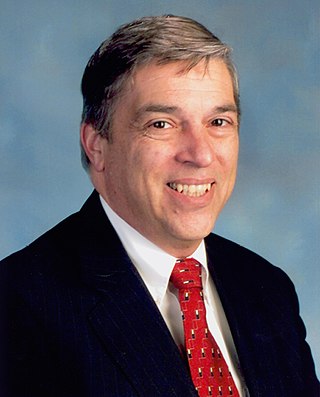
Robert Philip Hanssen was an American Federal Bureau of Investigation (FBI) agent who spied for Soviet and Russian intelligence services against the United States from 1979 to 2001. His espionage was described by the Department of Justice as "possibly the worst intelligence disaster in U.S. history".
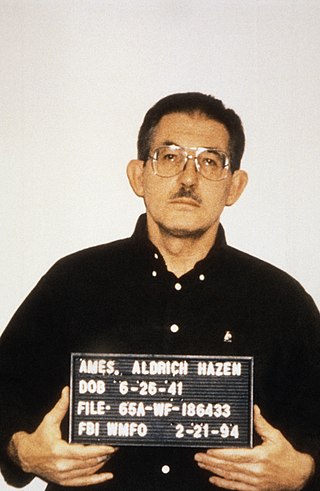
Aldrich Hazen "Rick" Ames is a former CIA counterintelligence officer who was convicted of espionage on behalf of the Soviet Union and Russia in 1994. He is serving a life sentence, without the possibility of parole, in the Federal Correctional Institution in Terre Haute, Indiana. Ames was known to have compromised more highly classified CIA assets than any other officer until Robert Hanssen, who was arrested seven years later in 2001.
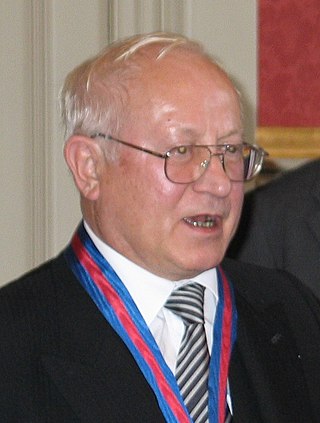
Oleg Antonovich Gordievsky, CMG is a former colonel of the KGB who became KGB resident-designate (rezident) and bureau chief in London, and was a double agent, providing information to the British Secret Intelligence Service (MI6) from 1974 to 1985. After being recalled to Moscow under suspicion, he was exfiltrated from the Soviet Union in July 1985 under a plan code-named Operation Pimlico. The Soviet Union subsequently sentenced him to death in absentia.

The Foreign Intelligence Service of the Russian Federation or SVR RF is Russia's external intelligence agency, focusing mainly on civilian affairs. The SVR RF succeeded the First Chief Directorate (PGU) of the KGB in December 1991. The SVR has its headquarters in the Yasenevo District of Moscow.

Oleg Vladimirovich Penkovsky, codenamed Hero and Yoga was a Soviet military intelligence (GRU) colonel during the late 1950s and early 1960s. Penkovsky informed the United States and the United Kingdom about Soviet military secrets, most importantly, the appearance and footprint of Soviet intermediate-range ballistic missile installations and the weakness of the Soviet intercontinental ballistic missile program. This information was decisive in allowing the US to recognize that the Soviets were placing missiles in Cuba before most of them were operational. It also gave US President John F. Kennedy, during the Cuban Missile Crisis that followed, valuable information about Soviet weakness that allowed him to face down Soviet leader Nikita Khrushchev and resolve the crisis without a nuclear war.
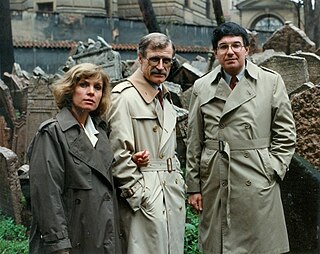
Karl František Koecher is a Czech mole known to have penetrated the CIA during the Cold War.
Oleg Danilovich Kalugin is a former KGB general. He was during a time, head of KGB political operations in the United States and later a critic of the agency. After being convicted of spying for the West in absentia during a trial in Moscow, he remained in the US and was sworn in as a citizen on 4 August 2003.
As early as the 1920s, the Soviet Union, through its GRU, OGPU, NKVD, and KGB intelligence agencies, used Russian and foreign-born nationals, as well as Communists of American origin, to perform espionage activities in the United States, forming various spy rings. Particularly during the 1940s, some of these espionage networks had contact with various U.S. government agencies. These Soviet espionage networks illegally transmitted confidential information to Moscow, such as information on the development of the atomic bomb. Soviet spies also participated in propaganda and disinformation operations, known as active measures, and attempted to sabotage diplomatic relationships between the U.S. and its allies.
Victor Ivanovich Cherkashin is a former Soviet foreign counter-intelligence officer of the PGU KGB SSSR. He was the case officer for both Aldrich Ames, a CIA counter-intelligence officer, and Robert Hanssen, an FBI agent.
Adolf Georgiyevich Tolkachev was a Soviet electronics engineer who provided key documents to the United States Central Intelligence Agency (CIA) between 1979 and 1985. Working at the Soviet radar design bureau Phazotron as one of the chief designers, Tolkachev gave the CIA complete detailed information about projects such as the R-23, R-24, R-33, R-27, and R-60, S-300 missile systems; fighter-interceptor aircraft radars used on the MiG-29, MiG-31, and Su-27; and other avionics. He was executed as a spy in 1986.
Clayton J. Lonetree is a former U.S. Marine who was court-martialed and convicted of espionage for the Soviet KGB. The son of a Winnebago father and Navajo mother, he served nine years in prison for espionage. During the early 1980s, Lonetree was a Marine Corps Security Guard stationed at the Embassy of the United States in Moscow.

Edward Lee Victor Howard was a CIA case officer who defected to the Soviet Union.
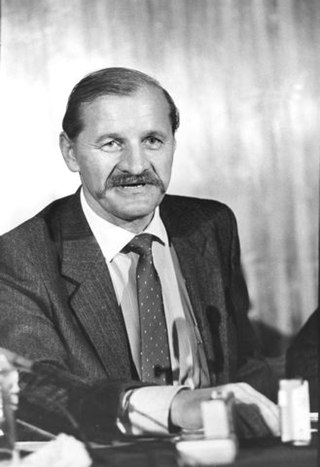
Vitaly Sergeyevich Yurchenko is a former high-ranking KGB disinformation officer in the Soviet Union. After 25 years of service in the KGB, he defected to the United States during an assignment in Rome. After providing the names of two U.S. intelligence officers as KGB agents and claiming that Lee Harvey Oswald was never recruited by the KGB, Yurchenko slipped from the Americans and returned to the Soviets. It is clear that his initial defection was illegitimate, because Yurchenko was awarded the Order of the Red Star from the Soviet government for the successful "infiltration operation."
George Trofimoff was a United States military intelligence officer of Russian descent. He was convicted in a U.S. federal court of having spied for the Soviet Union during the 1970s and 1980s. He was sentenced to life imprisonment on September 27, 2001. George Trofimoff is the most senior officer in U.S. military history to have been charged with or convicted of espionage.
Fedora was the codename for Aleksey Kulak (1923–1983), a KGB-agent who infiltrated the United Nations during the Cold War. One afternoon in March 1962, Kulak walked into the FBI's NYC field office in broad daylight and offered his services. Kulak told his American handlers there was a KGB mole working at the FBI, leading to a decades-long mole hunt that seriously disrupted the agency. Although the FBI's official position for a few years in the late 1970s and early 1980s was that Fedora had been Kremlin-loyal all along, that position was reversed to its original one in the mid 1980s, and Fedora is now said by the Bureau to have been spying faithfully for the FBI from when he "walked in" in March 1962 until he returned to Moscow for good in 1977.
William Peter Kampiles is a former United States Central Intelligence Agency (CIA) employee during the Cold War known for selling a top secret KH-11 spy satellite manual in 1977.
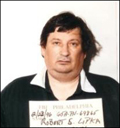
Robert Stephen Lipka was a former army clerk at the National Security Agency (NSA) who, in 1997, pleaded guilty to conspiracy to commit espionage and was sentenced to 18 years in prison. He was arrested more than 30 years after his betrayal, as there is no statute of limitations for espionage.
George Sadil is a former Russian analyst and translator who worked with the Australian Security Intelligence Organisation (ASIO) for nearly 25 years including during the height of the Cold War. After it had been revealed the ASIO had been compromised by a Russian KGB 'mole', investigations were held and after internal audits conducted by both ASIO (Jabaroo) and the Australian Federal Police, Sadil was accused of being the mole. After raids on the homes of many of their analysts and translators, the authorities found highly classified documents in Sadil's home, he was then charged with possessing classified federal documents under the Crimes Act 1914. In 1994 the case against him collapsed. Sadil's profile did not match that of the mole in question, and prosecutors were unable to establish any kind of money trail between Sadil and the KGB.

In 1995 it was revealed that the Central Intelligence Agency had delivered intelligence reports to the U.S. government between 1986 and 1994 which were based on agent reporting from confirmed or suspected Soviet operatives. From 1985 to his arrest in February 1994, CIA officer and KGB mole Aldrich Ames compromised Agency sources and operations in the Soviet Union and Eastern Europe, leading to the arrest of many CIA agents and the execution of at least ten of them. This allowed the KGB to replace the CIA agents with its own operatives or to force them to cooperate, and the double agents then funneled a mixture of disinformation and true material to U.S. intelligence. Although the CIA's Soviet-East European (SE) and Central Eurasian divisions knew or suspected the sources to be Soviet double agents, they nevertheless disseminated this "feed" material within the government. Some of these intelligence reports even reached Presidents Ronald Reagan and George H. W. Bush, as well as President-elect Bill Clinton.








